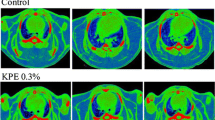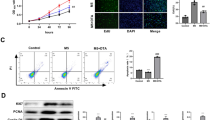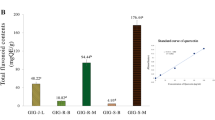Abstract
Obesity results from excessive energy intake and physical inactivity, and predisposes one to various diseases. One of these reasons is that enlargement of adipocytes raises the lipid metabolic abnormalities that affect various organs. The skin is one such organ, and it has been reported that subcutaneous adipocyte cells secrete various factors and these factors are involved in reduction of dermal collagen fibers and fragility of the skin in obesity. The present study explored the efficacy of Kaempferia parviflora (KP) in preventing obesity-induced dermatopathy. We used Tsumura Suzuki obese diabetes (TSOD) mice as an obesity model. TSOD mice were fed a standard diet (MF) mixed with either an ethanol extract from KP (KPE), polymethoxyflavonoid-rich extract from KP (PMF), or polymethoxyflavonoid-poor extract from KP (X). We then evaluated the effect of these three KP fractions on aging-like skin damage induced by UVB irradiation. KPE and PMF caused a significant decrease of mouse body weight, and suppressed the increase in the thickness of the subcutaneous fat layer. In addition, KPE shifted the frequency of subcutaneous adipocyte sizes towards smaller cells possibly via its polypharmacological actions. Scanning electron microscopy revealed that the stereostructure of the collagenous fibers in the dermis was better retained in the KPE and PMF groups, in that order. These results offer the first evidence that KPE can attenuate obesity-induced dermatopathy more effectively than PMF, suggesting that KPE (or KP) might be a candidate supplement for preventing obesity-related skin disorders.






Similar content being viewed by others
References
Ministry of Health, Labour and Welfare (2013) National health and nutrition examination survey results summary. http://www.mhlw.go.jp/file/04-Houdouhappyou-10904750-Kenkoukyoku-Gantaisakukenkouzoushinka/0000106403.pdf. Accessed 21 Dec 2015
Mount P, Davies M, Choy SW, Cook N, Power D (2015) Obesity-related chronic kidney disease-the role of lipid metabolism. Metabolites 5(4):720–731
Ezure T, Amano S (2010) Increased subcutaneous adipose tissue impairs dermal function in diet-induced obese mice. Exp Dermatol 19(10):878–882
Ibuki A, Akase T, Nagase T, Minematsu T, Nakagami G, Horii M, Sagara H, Komeda T, Kobayashi M, Shimada T, Aburada M, Yoshimura K, Sugama J, Sanada H (2012) Skin fragility in obese diabetic mice: possible involvement of elevated oxidative stress and upregulation of matrix metalloproteinases. Exp Dermatol 21(3):178–183
Lerman OZ, Galiano RD, Armour M, Levine JP, Gurtner GC (2003) Cellular dysfunction in the diabetic fibroblast: impairment in migration, vascular endothelial growth factor production, and response to hypoxia. Am J Pathol 162(1):303–312
Akase T, Nagase T, Huang L, Ibuki A, Minematsu T, Nakagami G, Ohta Y, Shimada T, Aburada M, Sugama J, Sanada H (2012) Aging-like skin changes induced by ultraviolet irradiation in an animal model of metabolic syndrome. Biol Res Nurs 14(2):180–187
Kusirisin W, Srichairatanakool S, Lerttrakarnnon P, Lailerd N, Suttajit M, Jaikang C, Chaiyasut C (2009) Antioxidative activity, polyphenolic content and anti-glycation effect of some Thai medicinal plants traditionally used in diabetic patients. Med Chem 5(2):139–147
Sae-wong C, Tansakul P, Tewtrakul S (2009) Anti-inflammatory mechanism of Kaempferia parviflora in murine macrophage cells (RAW 264.7) and in experimental animals. J Ethnopharmacol 124(3):576–580
Rujjanawate C, Kanjanapothi D, Amornlerdpison D, Pojanagaroon S (2005) Anti-gastric ulcer effect of Kaempferia parviflora. J Ethnopharmacol 102(1):120–122
Horigome S, Yoshida I, Tsuda A, Harada T, Yamaguchi A, Yamazaki K, Inohana S, Isagawa S, Kibune N, Satoyama T, Katsuda S, Suzuki S, Watai M, Hirose N, Mitsue T, Shirakawa H, Komai M (2014) Identification and evaluation of anti-inflammatory compounds from Kaempferia parviflora. Biosci Biotechnol Biochem 78(5):851–860
Albrecht M, Frungieri MB, Kunz L, Rämsch R, Meineke V, Köhn FM, Mayerhofer A (2005) Divergent effects of the major mast cell products histamine, tryptase and TNF-alpha on human fibroblast behaviour. Cell Mol Life Sci 62(23):2867–2876
Akase T, Shimada T, Terabayashi S, Ikeya Y, Sanada H, Aburada M (2011) Antiobesity effects of Kaempferia parviflora in spontaneously obese type II diabetic mice. J Nat Med 65(1):73–80
Park JE, Pyun HB, Woo SW, Jeong JH, Hwang JK (2013) The protective effect of Kaempferia parviflora extract on UVB-induced skin photoaging in hairless mice. Photodermatol Photoimmunol Photomed 30(5):237–245
Parlee SD, Lentz SI, Mori H, MacDougald OA (2014) Quantifying size and number of adipocytes in adipose tissue. Method Enzymol 537:93–122
Simon BR, Learman BS, Parlee SD, Scheller EL, Mori H, Cawthorn WP, Ning X, Krishnan V, Ma YL, Tyrberg B, MacDougald OA (2014) Sweet taste receptor deficient mice have decreased adiposity and increased bone mass. PLoS One 9(1):e86454
Galarraga M, Campión J, Muñoz-Barrutia A, Boqué N, Moreno H, Martínez JA, Milagro F, Ortiz-de-Solórzano C (2012) Adiposoft: automated software for the analysis of white adipose tissue cellularity in histological sections. J Lipid Res 53(12):2791–2796
Amaro-Ortiz A, Yan B, D’Orazio JA (2014) Ultraviolet radiation, aging and the skin: prevention of damage by topical cAMP manipulation. Molecules 19(5):6202–6219
Geldenhuys S, Hart PH, Endersby R, Jacoby P, Feelisch M, Weller RB, Matthews V, Gorman S (2014) Ultraviolet radiation suppresses obesity and symptoms of metabolic syndrome independently of vitamin D in mice fed a high-fat diet. Diabetes 63(11):3759–3769
Horikawa T, Shimada T, Okabe Y, Kinoshita K, Koyama K, Miyamoto K, Ichinose K, Takahashi K, Aburada M (2012) Polymethoxyflavonoids from Kaempferia parviflora induce adipogenesis on 3T3-L1 preadipocytes by regulating transcription factors at an early stage of differentiation. Biol Pharm Bull 35(5):686–692
Okabe Y, Shimada T, Horikawa T, Kinoshita K, Koyama K, Ichinose K, Aburada M, Takahashi K (2014) Suppression of adipocyte hypertrophy by polymethoxyflavonoids isolated from Kaempferia parviflora. Phytomedicine 21(6):800–806
Mekjaruskul C, Jay M, Sripanidkulchai B (2012) Pharmacokinetics, bioavailability, tissue distribution, excretion, and metabolite identification of methoxyflavones in Kaempferia parviflora extract in rats. Drug Metab Dispos 40(12):2342–2353
Junqueira LC, Montes GS, Martins JE, Joazeiro PP (1983) Dermal collagen distribution. A histochemical and ultrastructural study. Histochemistry 79(3):397–403
Gesta S, Tseng YH, Kahn CR (2007) Developmental origin of fat: tracking obesity to its source. Cell 131(2):242–256
Chau YY, Bandiera R, Serrels A, Martínez-Estrada OM, Qing W, Lee M, Slight J, Thornburn A, Berry R, McHaffie S, Stimson RH, Walker BR, Chapuli RM, Schedl A, Hastie N (2014) Visceral and subcutaneous fat have different origins and evidence supports a mesothelial source. Nat Cell Biol 16(4):367–375
Kobayashi H, Horiguchi-Babamoto E, Suzuki M, Makihara H, Tomozawa H, Tsubata M, Shimada T, Sugiyama K, Aburada M (2016) Effects of ethyl acetate extract of Kaempferia parviflora on brown adipose tissue. J Nat Med 70(1):54–61
Labbé SM, Caron A, Lanfray D, Monge-Rofarello B, Bartness TJ, Richard D (2015) Hypothalamic control of brown adipose tissue thermogenesis. Front Syst Neurosci 9:150
Acknowledgments
This work was supported by a grant-in-aid for Scientific Research from MEXT (Ministry of Education Culture, Sports, Science and Technology) (No. 1224593252).
Author information
Authors and Affiliations
Corresponding author
Electronic supplementary material
Below is the link to the electronic supplementary material.
Rights and permissions
About this article
Cite this article
Hidaka, M., Horikawa, K., Akase, T. et al. Efficacy of Kaempferia parviflora in a mouse model of obesity-induced dermatopathy. J Nat Med 71, 59–67 (2017). https://doi.org/10.1007/s11418-016-1027-8
Received:
Accepted:
Published:
Issue Date:
DOI: https://doi.org/10.1007/s11418-016-1027-8




